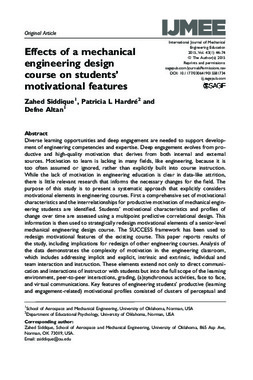| dc.description.abstract | Diverse learning opportunities and deep engagement are needed to support development of engineering competencies and expertise. Deep engagement evolves from productive and high-quality motivation that derives from both internal and external sources. Motivation to learn is lacking in many fields, like engineering, because it is too often assumed or ignored, rather than explicitly built into course instruction. While the lack of motivation in engineering education is clear in data-like attrition, there is little relevant research that informs the necessary changes for the field. The purpose of this study is to present a systematic approach that explicitly considers motivational elements in engineering courses. First a comprehensive set of motivational characteristics and the interrelationships for productive motivation of mechanical engineering students are identified. Students’ motivational characteristics and profiles of change over time are assessed using a multipoint predictive correlational design. This information is then used to strategically redesign motivational elements of a senior-level mechanical engineering design course. The SUCCESS framework has been used to redesign motivational features of the existing course. This paper reports results of the study, including implications for redesign of other engineering courses. Analysis of the data demonstrates the complexity of motivation in the engineering classroom, which includes addressing implicit and explicit, intrinsic and extrinsic, individual and team interaction and instruction. These elements extend not only to direct communication and interactions of instructor with students but into the full scope of the learning environment, peer-to-peer interactions, grading, (a)synchronous activities, face to face, and virtual communications. Key features of engineering students’ productive (learning and engagement-related) motivational profiles consisted of clusters of perceptual and experiential variables that were strongly correlated with motivational and learning outcomes. Tracking these factors demonstrated that they changed over time. These changes corresponded to perceptions of instructor and peer interactions, which were amenable to instructional intervention and responsive to social modeling. This study also revealed links among engineering students’ perceptions of their field of study, their own development of self-efficacy, and success expectations in both the design course and for their careers. This work revealed important distinctions between engineering students’ self-efficacy for, and engagement in, the course generally and for group tasks more specifically. These newly revealed relationships offer the opportunity to improve engineering instruction and the design of dynamic learning environments that support adaptive skill development. | en_US |
